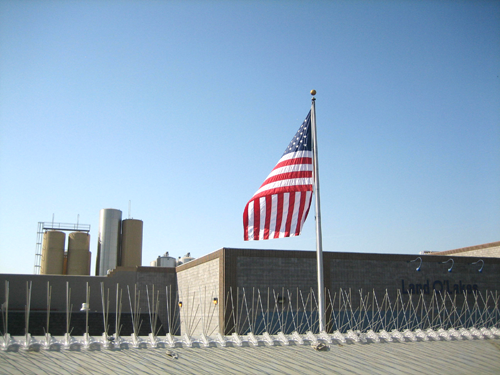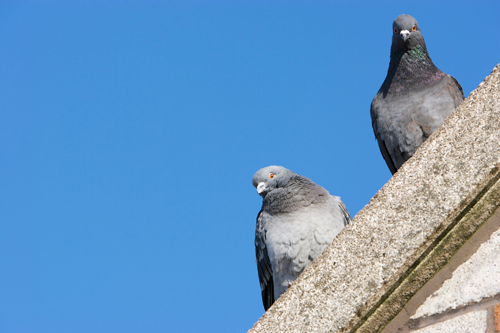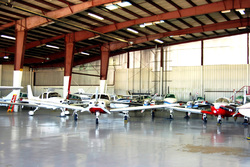
by Alex A. Kecskes
No matter how you feel about birds, when they invade your property en masse, they can be a real nuisance. Consider the damage just a few bids can do to your gutters, rooftop AC units, skylights, air vents and solar panels. Over time, their acidic droppings eat into these areas and devices, which can be very costly to repair or replace. Bird droppings left on your car, van, boat or RV can ruin the finish, especially if you wait too long to wash off the droppings.
There’s also the problem of bird nests and nesting debris, which can cause fires when they are built too close to any electrical device, exterior wiring or light fixture.
Finally, if you fancy eating outdoors, there’s the problem of diseases that pest birds carry—they can transmit any of 60 known diseases. Unless you control pest birds with bird guards or bird barriers, they will land on tables, chairs, BBQs awnings, pool ledges and spa areas. And every time they do, there’s the potential for them to drop a disease carrying “load.”
The solution, of course, is to install bird guards and bird barriers on your property. Two of the most popular bird control devices that fall into these categories are Bird Spikes and Bird Netting.
Bird Spikes Won’t Let ‘em Land
Whether you get stainless steel spikes or plastic, these deterrents are humane and highly effective. Both are easy to install and essentially maintenance free. The plastic bird spikes cost a bit less and come in 3-, 5- and 7-inch widths and two-foot spike strips. A single row of bird spikes usually covers a 7-inch wide area. The best plastic spikes have a flexible base that adapts to curved surfaces. Each spiked strip comes pre-drilled with holes along the base. The strips can also glued in place by using a glue trough at the base of each spike strip. Concerned about how bird spikes will look on your property? Not to worry. They now come in a full range of colors--including white, tan, gray, black, brown, brick red and even crystal clear. Custom colors are also available.
Create a Bird-Proof Barrier with Bird Netting
Bird Netting creates a barrier that blocks out most pest birds. It can keep everything from sparrows to pigeons from invading the nooks and crannies of your property. What’s more, like bird spikes, netting is a humane bird deterrent that won’t harm birds.
For bird netting that lasts, opt for Heavy-Duty polyethylene Bird Netting. It’s made from a U.V. stabilized mesh and comes in various sizes and custom cuts. The key here is to choose the right mesh size for the pest bird you’re having problems with. The three most popular mesh sizes include 2-inch mesh, 1 1/8-inch mesh, and 3/4-inch mesh.
The most rugged netting is ISO 1806 protocol mesh tested, flame resistant and rot- and waterproof. This durable netting consists of 6 monofilaments, each12/1000s of an inch thick. The monofilaments are twisted together to create a tough twine with 160-200 twists per meter. This high quality bird proof netting is frequently specified by architects.
To get the most deterrent effect out of bird netting, you must install it properly. Before installing Heavy Duty Bird Netting, thoroughly clean the area of bird droppings, nesting materials, loose rust, peeling paint or other debris. Improperly installed netting will sag or droop, leaving gaps that birds can work through. The one thing to remember here is that pest birds can be very resourceful when it comes to sneaking through netting. For best results in large installations, cables should be set up around the area and the net should then be attached to this cable.

by Alex A. Kecskes
If your driveway and parked cars are always covered with bird droppings, you need some serious bird control. If your weathervane has been stuck in the same position for the last 5 years, you need some major bird barriers. If that brand new garage door you just installed is already covered with bird poop, it’s time for you to get rid of birds.
Keep in mind that bird droppings can eat into and permanently mar most materials. That includes metal or wood siding, the paint on your car, boat or RV, and even that fancy stonework that gives your home such character. Yes, over time, bird droppings can cause even stone to crumble. And lest we not forget the damage bird droppings, nests and debris can cause to your AC units, solar panels, dish TV antennas, rotating rooftop vents and skylights. It all adds up to one big costly headache.
You’re probably thinking that you can just shoo them away with noisemakers or maybe take a pot shot at them with your BB gun. Not a good idea. BBs bounce all over the place and crack windows and strike unintended victims like dogs and (heaven forbid your kids). Noisemakers are just temporary. Birds always come back. What to do?
Fortunately, there are a number of bird barriers you can use to get rid of pest birds. Here are three of today’s most popular bird control solutions:
Lightweight Plastic Bird Netting
Easy to install and handle, this netting denies pest birds access to all those safe little nooks and crannies on the front of your home—places where they can land, build nests and perch before they attack your car, boat or RV. This bird netting comes in several mesh sizes to block out pigeons, sparrows, starlings, seagulls and other birds. One manufacturer offers netting in a full spectrum of colors to blend in with your home’s color scheme.
Sonic Bird Deterrents
These devices emit distress and predator calls that make birds too nervous to hang around your home. Some devices broadcast the sound of Peregrine falcons (a pigeon's dreaded enemy) defending their territory. Others emit the sounds of predator hawks screeching and gulls under attack. One of the most versatile sonic bird deterrents generates distress and predator calls for 22 different types of birds. By they way, these sounds resemble natural birdcalls to the human ear, so they won’t bother you, your neighbors or your pets.
Red-Tail Hawk Decoys
Most birds fear hawks—especialy Red Tail Hawks. That's why a realistic looking hawk decoy can keep birds away from your front porch or driveway. The point is to get a quality made hawk decoy that looks real and stays looking real after several rainy seasons and hot summers. Just remember, most birds won't be fooled for long, so you'll need to move these decoys around every week or so.
 by Fran Prisco Pigeons can be found in just about every city and suburb in North America. They were first introduced to the United States as domesticated birds that soon escaped and formed wild pigeon populations. Ancestors of the Rock Dove, city pigeons like to roost and nest high atop buildings where there is safety from predators. They cause thousands of dollars every year to buildings and homes across the country. The droppings of pigeons are acidic and will accelerate the deterioration of building materials. Pigeon droppings also can carry any of 60 plus transmitted diseases. The best way to keep pest pigeons off of buildings is to install some sort of bird barrier . Sanitation It is important that all debris and droppings left behind by the pigeons is removed before installing any type of bird barrier . Inhaling the dust from pigeon droppings has been known to cause histoplasmosis, cryptococcus and psittaicosis. If you use some simple protective methods while cleaning up pigeon droppings, you can eliminate the danger of catching any of the above-mentioned diseases. Be sure to wear some sort of protective gear such as a facemask and rubber gloves. Wet pigeon droppings with water so that they do not emit any dry dust, use a scraper to scrape the wet droppings into a dustpan and dispose of them in trash bags. Types of Bird Barriers Electric Bird Barriers are electrified track that give pigeons a small “jolt” when they touch the track. They are easily installed on parapet walls, roof edges and peaks, ledges and even channel letters. Install the track with an outdoor adhesive and connect to a solar or direct charger. When the pigeons are “Zapped” by the electrical current running through the track, they will change their landing and roosting habits and find another more comfortable area. Electric bird repellents are low profile, usually no more than ¼” high, which does not take away from the buildings aesthetics. These bird control electric tracks are one of the most specified systems by architects, government offices and contractors.
Bird Netting is used on and in commercial buildings with severe bird problems. Bird net is an exclusionary bird deterrent; it excludes birds from areas that they are unwanted. Bird netting is ideal to use in large warehouses, airplane hangars, “Big Box” stores and food processing plants. It can also be used on building facades to protect signs, channel letters and architectural features. It is best to hire a professional to install bird netting , if not done properly, the netting may sag and allow birds to get underneath it. Bird Spikes are an ideal way to keep larger birds such as pigeons and gulls from landing on commercial buildings. They are easily installed using adhesive, screws or tie downs. Use bird spikes to keep birds from landing on ledges, roof edges and peaks, parapet walls, windowsills and other flat surfaces. Be sure to cover the entire surface with bird spikes so the birds cannot land around them. Often times, if birds can land around the spikes, they will use them as a nesting area. Made from stainless steel or polycarbonate plastic, bird spikes are rugged and long lasting bird barriers . Once installed there is little maintenance; periodic cleaning of debris buildup from nearby trees or shrubs is all it takes.
 By Alex A. Kecskes Pest birds can be a huge problem when they congregate and nest in airport hangars. Without effective pest bird barriers to exclude them, hangar operators spend millions of dollars every year in maintenance and cleanup costs. Once pest birds invade a hangar, they settle in, make themselves at home, and seldom leave on their own. These birds can create considerable damage to aircraft and exposed aircraft engines and assemblies with their nesting materials and droppings. The acidic chemicals in droppings can eat into metal, plastic and rubber surfaces, causing long-term damage that may cause engines and hydraulic systems to fail--even in flight. Bird nests and droppings can also clog gutters and down pipes. Fecal matter sucked into grilles, ducts and vents can damage expensive AC systems. Bird droppings left to gather on hangar floors, entrances and ladders could create dangerous slip-and-fall hazards and result in a costly legal liability. The right kind of bird barriers can reduce or prevent these problems. Pest bird droppings and nesting materials also pose a considerable health hazard, carrying and transmitting any of 60 known diseases--including Salmonellosis and Ornithosis, which is similar to viral pneumonia. In addition, bird droppings and nesting materials contain insects and mites, which can also damage aircraft and delicate assemblies. Fortunately, there are effective and humane bird barrier products one can install to keep pest birds out of aircraft hangars.
|


 by Fran Prisco
by Fran Prisco
 RSS Feed
RSS Feed